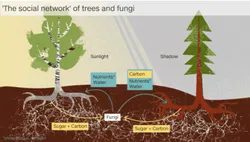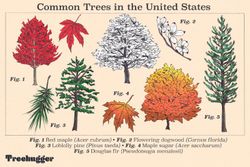Sep 30, 2022
Dendrophile

Dendrophile
1. Can trees make you happy?
Spending time around trees and looking at trees reduces stress, lowers blood pressure and improves mood. Numerous studies show that both exercising in forests and simply sitting looking at trees reduce blood pressure as well as the stress-related hormones cortisol and adrenaline.
Dendrophile (den · druh · file)
2. Immerse Yourself in a Forest for Better Health
Most of us sense that taking a walk in a forest is good for us. We take a break from the rush of our daily lives. We enjoy the beauty and peace of being in a natural setting. Now, research is showing that visiting a forest has real, quantifiable health benefits, both mental and physical. Even five minutes around trees or in green spaces may improve health. Think of it as a prescription with no negative side effects that's also free.
3. Health Benefits From Forests
boosts the immune system
lowers blood pressure
reduces stress
improves mood
increases ability to focus, even in children with ADHD
accelerates recovery from surgery or illness
increases energy level
improves sleep
Forests Make Us Healthier
4. Numerous studies in the U.S. and around the world are exploring the health benefits of spending time outside in nature, green spaces, and, specifically, forests. Recognizing those benefits, in 1982, the Japanese Ministry of Agriculture, Forestry and Fisheries even coined a term for it: shinrin-yoku. It means taking in the forest atmosphere or "forest bathing," and the ministry encourages people to visit forests to relieve stress and improve health.
5. Research is casting light on how spending time outdoors and in forests makes us healthier:
Exposure to forests boosts our immune system. While we breathe in the fresh air, we breathe in phytoncides, airborne chemicals that plants give off to protect themselves from insects. Phytoncides have antibacterial and antifungal qualities which help plants fight disease. When people breathe in these chemicals, our bodies respond by increasing the number and activity of a type of white blood cell called natural killer cells or NK. These cells kill tumor- and virus-infected cells in our bodies. In one study, increased NK activity from a 3-day, 2-night forest bathing trip lasted for more than 30 days. Japanese researchers are currently exploring whether exposure to forests can help prevent certain kinds of cancer.
6. Spending time around trees and looking at trees reduces stress, lowers blood pressure and improves mood. Numerous studies show that both exercising in forests and simply sitting looking at trees reduce blood pressure as well as the stress-related hormones cortisol and adrenaline. Looking at pictures of trees has a similar, but less dramatic, effect. Studies examining the same activities in urban, unplanted areas showed no reduction of stress-related effects. Using the Profile of Mood States test, researchers found that forest bathing trips significantly decreased the scores for anxiety, depression, anger, confusion and fatigue. And because stress inhibits the immune system, the stress-reduction benefits of forests are further magnified.
7. Green spaces in urban areas are just as important as rural forests. About 85% of the US population lives in suburban and urban areas and may not have access to traditional rural forests. That's O.K. Gardens, parks and street trees make up what is called an urban and community forest. These pockets of greenspace are vitally important because they are the sources of our daily access to trees.
8. Spending time in nature helps you focus. Our lives are busier than ever with jobs, school, and family life. Trying to focus on many activities or even a single thing for long periods of time can mentally drain us, a phenomenon called Directed Attention Fatigue. Spending time in nature, looking at plants, water, birds and other aspects of nature gives the cognitive portion of our brain a break, allowing us to focus better and renew our ability to be patient.
9. In children, attention fatigue causes an inability to pay attention and control impulses. The part of the brain affected by attention fatigue (right prefrontal cortex) is also involved in Attention-Deficit/Hyperactivity Disorder (ADHD). Studies show that children who spend time in natural outdoor environments have a reduction in attention fatigue and children diagnosed with ADHD show a reduction in related symptoms. Researchers are investigating the use of natural outdoor environments to supplement current approaches to managing ADHD. Such an approach has the advantages of being widely accessible, inexpensive and free of side effects.
10. Patients recover from surgery faster and better when they have a "green" view. Hospital patients may be stressed from a variety of factors, including pain, fear, and disruption of normal routine. Research found that patients with "green" views had shorter postoperative stays, took fewer painkillers, and had slightly fewer postsurgical complications compared to those who had no view or a view of a cement wall.
11. What Happens if We Lose Trees
The invasion of the emerald ash borer, or EAB, since 2002 has provided an unfortunate opportunity to look at the effect of tree-loss on human health. EAB is a non-native, wood-boring beetle that kills all species of ash (Fraxinus) trees within three years after infestation. In some communities, entire streets lined with ash were left barren after the beetle arrived in their neighborhood. A study looked at human deaths related to heart and lung disease in areas affected by EAB infestations. It found that across 15 states, EAB was associated with an additional 6,113 deaths related to lung disease and 15,080 heart-disease-related deaths.
12. More Research is Needed
While the research in Japan is groundbreaking, we need more research on trees growing in the Northeastern US. We share some of the same genera with Japan, like pine, birch and oak, which all give off different phytoncides, but we have different species. The more we know about our local trees, the more applicable the science will be.
13. Why we should love trees
It’s no secret that I go nuts for the trees. I talk to them, I pet them ... the Lorax is my spirit animal! So it’s no surprise that Arbor Day, generally observed on the last Friday of April, holds a special place in my heart. What could be better than a day dedicated to observing the importance of trees and better yet, to planting new ones?
It’s funny because I often think about how vital it is to be good stewards to trees – but when I muse upon how critical they are for us, I think that maybe I have it all wrong. What if it’s the trees who have been acting as good stewards to us all along?
14. Arbor Day in the United States was officially designated in Nebraska in 1872 – pioneers moving to the treeless plains realized they needed trees for things like fruit, windbreaks, fuel, building materials and shade. Essentially, food and shelter and the necessities for survival. So who’s taking care of whom here? We need trees, but do trees need us? They need us not to cut them down indiscriminately, for sure, but really they seem to be doing most of the work in this relationship.
And so with that in mind, here are just some of the many many reasons why it’s imperative to respect and celebrate the trees; the fact is, humans need trees much more than trees need humans! Consider the following:
15. Trees Work Hard to Right Our Wrongs
According to the U.S. Forest Service, the trees around the world removed about one-third of fossil fuel emissions annually between 1990 to 2007.
16. They Help Keep Our Houses Clean
A study from Lancaster University found that trees by the road reduced the presence of airborne particulate matter (pollution from cars) inside nearby homes by 50 percent.
17. They Ease the Workday
Office workers who can gaze upon trees from their windows report less stress and more satisfaction, according to a study from Chungbuk University, South Korea.
18. Trees Feed Us and Give Us Pie
Trees provide food for people and wildlife beyond what we likely imagine. A single apple tree alone can produce up to 15-20 bushels of fruit per year. Apples, pie, important!
19. They Provide Shelter and Support
Three hundred million people across the globe live in forests and 1.6 billion depend on them for their livelihoods, according to the World Wildlife Fund. Forests also provide habitat for a mind-boggling array of plants and creatures, many of which we don't even know about.
6. They Show Us How to Age Gracefully
Seriously, talk about respecting your elders. The world’s oldest tree is an ancient bristlecone pine named Methuselah that lives at 10,000 feet above sea level in the Inyo National Forest, California. Methuselah is as old as Stonehenge and older than the Egyptian pyramids.
7. Trees Keep Cities Cool
Trees lower urban temperatures by up to 10°F by shading and releasing water vapor into the air through their stress-soothing leaves.
8. They Are Giant Humidifiers
In a single day, one large tree can lift up to 100 gallons of water out of the ground and discharge it into the air.
9. They Keep Buildings Comfortable
Of course shade trees produce shade; a lot. Strategically placed trees can cut down air conditioning needs by 30 percent and can save up to 50 percent in energy required for heating.
10. Trees are Social Beings
"They can count, learn and remember; nurse sick neighbors; warn each other of danger by sending electrical signals across a fungal network known as the 'Wood Wide Web' – and, for reasons unknown, keep the ancient stumps of long-felled companions alive for centuries by feeding them a sugar solution through their roots." That's not me being woo-woo, but a very poetic tree expert.
11. They Devour Carbon Dioxide
Biology 101 tells us that trees absorb carbon dioxide (CO2), removing and storing the carbon while releasing the oxygen back into the air – but the amount is remarkable. In a single year, an acre of mature trees absorbs the amount of CO2 equivalent to a car driven 26,000 miles.
12. Likewise, They Give Us Breath
Four people can get a day’s worth of oxygen from one large tree.
13. And Water
In the United States, watersheds protected by forests provide water to more than 180 million people.
14. Trees Fight Crime
A study by the University of Vermont and U.S. Forest Service found that in Baltimore alone, a 10 percent increase in tree canopy corresponded to a 12 percent drop in crime.
15. They Fight Grime
In outdoor spaces with trees, there is less graffiti, vandalism and littering in comparison to place without greenery, says a study from the University of Washington.
16. They Give Us Something to Look Up to, Literally
looking up at group of California redwood trees (Sequoia sempervirens) are some of the tallest in the world
The tallest living tree is a towering 379.1-foot coast redwood (Sequoia sempervirens) in California's Redwood National Park in 2006. Called Hyperion, it miraculously survives on a hillside, rather than the more-typical alluvial flat, with 96 percent of the surrounding area having been logged of its original coast redwood growth.
17. They Pay Us Back
For each dollar spent on planting a tree in the city, they pay us back by up to five times in terms of cleaner air, lower energy costs, improved water quality and storm water control and increased property values.
18. They're Ersatz War Heroes
Oak trees have long been prized for their attributes as well as their place in U.S. history, from Abraham Lincoln’s use of the Salt River Ford Oak as a marker in crossing a river near Homer, Illinois, to Andrew Jackson taking shelter under Louisiana’s Sunnybrook Oaks on his way to the Battle of New Orleans, notes the Arbor Day Foundation. "In the annals of military history, 'Old Ironsides,' the USS Constitution, took its nickname from the strength of its live oak hull, famous for repelling British cannonballs." See how well trees take care of us?
19. They Are Unassuming in Their Vastness
There are more than 23,000 different kinds of trees in the world; altogether, there are three trillion trees on the planet. Yet they just humbly stand by, working hard and never making too much of a fuss.
20. Trees Keep Us Young and Rich
And when all else fails, there's this: They may keep us young and rich! Research found that people who live on streets with high tree density are less likely to report a number of health complaints; and specifically, trees improve health perception in ways comparable to an increase in annual personal income of $10,000 or being seven years younger. You can never be too rich or too thin, and you can never live among too many trees. End of story.



Dendrophile
By undefined
7 notes ・ 61 views
English
Elementary